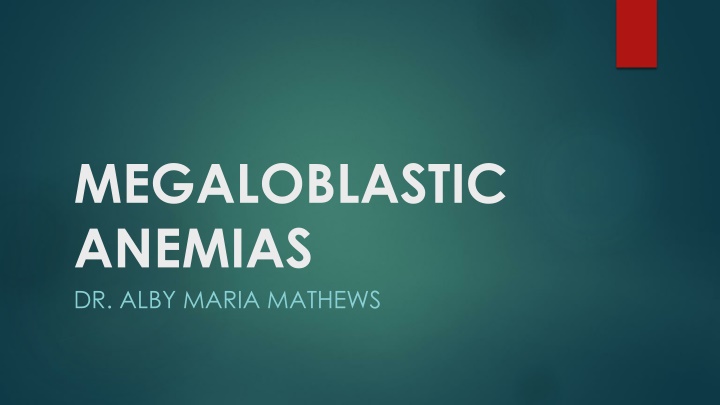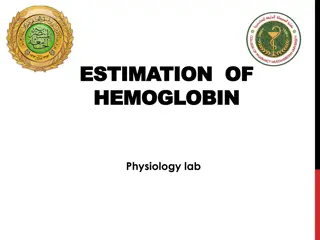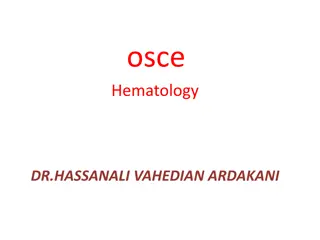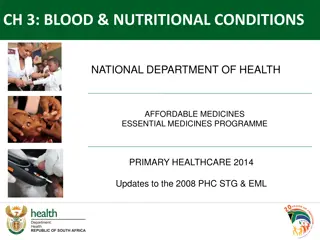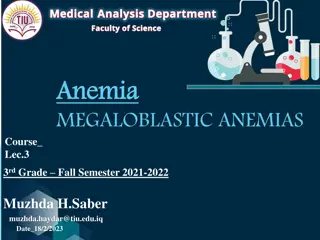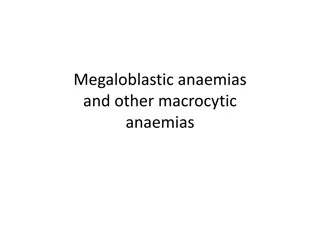MEGALOBLASTIC
Megaloblastic anemias are disorders characterized by distinctive morphological appearances of developing red cells in the bone marrow. This results in ineffective erythropoiesis, leading to anemia. The condition involves cobalamin (B12) deficiency, with three main forms found in nature. Dietary sources mainly include animal products, and absorption occurs through active and passive processes. The transport of cobalamin within the body and the importance of folate in the diet are also discussed.
Download Presentation

Please find below an Image/Link to download the presentation.
The content on the website is provided AS IS for your information and personal use only. It may not be sold, licensed, or shared on other websites without obtaining consent from the author.If you encounter any issues during the download, it is possible that the publisher has removed the file from their server.
You are allowed to download the files provided on this website for personal or commercial use, subject to the condition that they are used lawfully. All files are the property of their respective owners.
The content on the website is provided AS IS for your information and personal use only. It may not be sold, licensed, or shared on other websites without obtaining consent from the author.
E N D
Presentation Transcript
MEGALOBLASTIC ANEMIAS DR. ALBY MARIA MATHEWS
Megaloblastic anemias are group of disorders characterized by the presence of distinctive morphological appearances of the developing red cells in the bone marrow. Marrow is usually hypercellular and the anemia is based on ineffective erythropoiesis.
COBALAMIN 3 FORMS : In nature its mainly in 2 deoxy adenosyl form ( Ado ) located in mitochondria and cofactor for the enzyme L-methylmalonyl Coenzyme A mutase Methylcobalamin form in human plasma and cell cytoplasm. Cofactor for methionine synthase Methyl and ado cobalamin are converted to hydroxocobalamin rapidly by exposure to light.
Dietary sources: Only source for humans : animal products such as meat, fish and dietary products Adult daily requirement : 1 to 3 mcg per day
ABSORPTION active and passive Dietary cobalamin is released from protein complexes by enzymes Binds with salivary glycoprotein- haptocorrin Haptocorrin is digested in the intestine and cobalamin is transferred to IF. IF attaches to it specific receptor (cubulin) on enterocytes.
Transport 2 main transport proteins- Transcobalamin 1 : encoded by gene TCNL, derived from specific granules in neutrophils Binds with cobalamin and plays a role in the transport of cobalamin analogues in the liver for excretion in bile. Transcobalamin 2: transport of cobalamin to the marrow , placenta and other tissues via receptor mediated endocytosis involving the transcobalamin receptor and megalin.
FOLATE DIETARY FOLATE Highest conc. In liver, yeast, spinach and nuts. Daily adult requirement 1000 ug/day
ABSORPTION Dietary folate converted to 5 methyl THF in enterocytes. Monoglutamates are actively transported across the enterocyte by a proton coupled folate transporter(PCFT). 60 to 90 ug enters the bile
TRANSPORT One third is loosely bound to albumin and two thirds unbound. 3 types of transporters Reduced folate transporter- delivery of plasma folate to tissues. Folate receptors FR2 and FR3 transport folate into cell PCFT transports folate from vesicle to the cell cytoplasm.
BIOCHEMICAL BASIS OF MEGALOBLASTIC ANEMIA Disparity in the rate of synthesis or availability of the immediate precursors of DNA. In deficiencies of either folate or cobalamin, there is failure to convert deoxyuridine monophosphate (dUMP) to deoxythymidine monophosphate (dTMP) . Folate is needed as the coenzyme 5, 10-methylene- THF polyglutamate for the conversion of dUMP to dTMP.
DNA replication from multiple origins is slower. Failure of joining of incomplete replicons.
CLINICAL FEATURES EPITHELIAL SURFACES: Epithelial cell surfaces of the mouth (glossitis), stomach and small intestine and the respiratory, urinary and female genital tracts. Cells show macrocytosis, with increased numbers of epithelial and dying cells. Deficiencies may cause cervical smear abnormalities.
Gonads- infertility is common in both men and women. Maternal folate and cobalamin deficiency- prematurity, recurrent fetal loss and neural tube defects.
NEURAL TUBE DEFECTS: FA supplements has reduced the incidence of neural tube defects (anencephaly, meningomyelocele, encephalocele and spina bifida) Incidence of cleft lip and palate can also be reduced. Polymorphism in the MTHFR gene leading to reduced activity of 5, 10 methylene THF Reductase.
Cardiovascular disease- Patients with deficiency of one of the three enzymes, methionine synthase, MTHFR, or cystathionine synthase with homocystinuria have increased incidence of vascular disease like IHD, cerebrovascular disease or pulmonary embolus. Venous thrombosis is found to be more common in folate or b12 deficient subjects.
MALIGNANCY- Prophylactic folic acid has been found to have reduced the incidence of ALL and leukemias with mixed lineage leukemias. Other tumors associated with folate polymorphisms include follicular lymphoma, breast cancer and gastric cancer. Because FA may feed tumors, it probably should be avoided in those with established tumors unless there is severe megaloblastic anemia due to folate deficiency.
HEMATOLOGIC FINDINGS PERIPHERAL BLOOD Oval macrocytes with considerable anisocytosis and poikilocytosis MCV usually> 100 fL Hypersegmented neutrophils There may be leukopenia due to reduction in granulocytes and lymphocytes Platelet count may be moderately reduced In a non anemic patient, the presence of a few macrocytes and hypersegmented neutrophils may be the only indication of the underlying disorder.
BONE MARROW Hypercellular marrow Erythroblast nucleus appears primitive despite maturation and hemoglobinization of the cytoplasm. Giant and abnormally shaped metamyelocytes and enlarged hyperploid megakaryocytes are characteristic.
CHROMOSOMES Bone marrow cells, transformed lymphocytes and other proliferating cells in the body show random breaks reduced contraction, spreading of the centromere, and exaggeration of secondary chromosomal constrictions and overprominent satellites. Similar abnormalities may be caused by antimetabolite drugs (e.g: cytosine arabinoside, hydroxyurea, and methotrexate)
INEFFECTIVE HEMATOPOIESIS Accumulation of unconjugated bilirubin, raised urine urobilinogen, reduced haptoglobins and positive urine hemosiderin Raised s. LDH A weakly positive direct antiglobulin test due to complement can lead to false diagnosis of autoimmune hemolytic anemia.
CAUSES OF COBALAMIN DEFICIENCY Inadequate dietary intake- vegans Deficiency usually does not progress to megaloblastic anemia as the vegan diet is not completely lacking in cobalamin and the enterohepatic circulation is intact. Infants born to severely cobalamin-deficient mothers have shown growth retardation, impaired psychomotor development, and other neurological sequelae. MRI shows delayed myelination and atrophy.
GASTRIC CAUSES OF COBALAMIN DEFICIENCY Pernicious anemia Juvenile pernicious anemia- one half have associated endocrinopathy Congenital IF deficiency or functional abnormality- antibodies are absent. Child usually presents with megaloblastic anemia in the first to third yr. autosomal recessive. Gastrectomy Food cobalamin malabsorption- failure of release of cobalamin from binding proteins.
PERNICIOUS ANEMIA severe lack of IF due to gastric atrophy; Occurs more commonly in persons with other autoimmune diseases Gastric output of pepsin, hydrochloric acid and IF is severely reduced. Gastric biopsy- atrophy of all layers of the body and the fundus, with loss of glandular elements, absence of parietal and chief cells replaced by mucus cells, a mixed inflammatory cell infiltrate and intestinal metaplasia. H. pylori infection occurs infrequently in PA.
IF immunoglobulin antibodies: blocking or type 1 antibody- prevents combination of IF and cobalamin Type II antibody prevents attachment of IF to ileal mucosa.
INTESTINAL CAUSES OF COBALAMIN MALABSORPTION Intestinal stagnant loop syndrome Ileal resection Selective malabsorption of cobalamin with proteinuria (Imerslund syndrome; congenital cobalamin malabsorption; autosomal recessive megaloblastic anemia; MGA1) Tropical sprue Fish tapeworm infestation Gluten induced enteropathy
severe pancreatitis, HIV infection Radiotherapy Zollinger Ellison syndrome Drugs -colchicine, para aminosalicylic acid, neomycin, slow release potassium chloride, anticonvulsant drugs, metformin, cytotoxic drugs Graft versus host disease. Alcohol
ABNORMALITIES OF COBALAMIN METABOLISM Congenital transcobalamin II deficiency or abnormality Congenital methyl melonic acidemia or aciduria Acquired abnormality of cobalamin metabolism: nitrous oxide inhalation.
CAUSES OF FOLATE DEFICIENCY NUTRITIONAL: Nutritional folate deficiency occurs in infants with repeated infections, solely fed by goats milk, kwashiorkor, scurvy MALABSORPTION: tropical sprue, gluten induced enteropathy jejunal resection, partial gastrectomy sulfasalazine, cholestyramine and triamterene.
EXCESS UTILIZATION OR LOSS pregnancy prematurity Hematologic disorders- chronic hemolytic anemia Chronic inflammatory disease Homocystinuria Long term dialysis Congestive heart failure, liver disease- release of folate from damaged liver cells
ANTIFOLATE DRUGS PHENYTOIN OR PRIMIDONE Alcohol Methotrexate, pyrimethamine and trimethoprim CONGENITAL ABNORMALITIES OF FOLATE METABOLISM
DIAGNOSIS OF COBALAMIN AND FOLATE DEFICIENCIES
COBALAMIN DEFICIENCY Serum cobalamin: (ELISA) Normal levels range from 118-148 to 738 pmol/L Serum methyl malonate and homocysteine: Serum MMA levels can be used for the early diagnosis of cobalamin deficiency, even in the absence of hematological abnormalities. S. homocysteine is raised both in early cobalamin and folate deficiency
TESTS FOR THE CAUSE OF COBALAMIN DEFICIENCY Studies of cobalamin absorption- obsolete Tests to diagnose PA- raised s.gastrin, reduced s. pepsinogen 1, gastric endoscopy, IF and parietal cell antibodies.
FOLATE DEFICIENCY S. folate- 11 to 82 nmol/L S folate rises in severe cobalamin deficiency. Red cell folate- 880 to 3520 umol/L
TESTS FOR THE CAUSE OF FOLATE DEFICIENCY Diet history Transglutaminase antibodies.
COBALAMIN DEFICIENCY Indications for starting cobalamin deficiency well documented megaloblastic anemia or other hematologic abnormalities and neuropathy due to deficiency Replenishment of body stores- six 1000ug im inj of hydroxocobalamin given at 3 to 7 day intervals More frequent doses in neuropathy Large oral doses 1000- 2000 ug of cyanocobalamin are used in PA for replacement.
Vitamin b12 injections are used in a wide variety of diseases often neurologic, despite normal b12 and folate levels and normal blood counts. These conditions include multiple sclerosis and chronic fatigue syndrome / myalgic encephalomyelitis.
FOLATE DEFICIENCY Oral doses of 5 to 15mg folic acid daily for about 4 months till all folate deficient red cells have been eliminated and replaced. Long term folic acid therapy is required when underlying cause cannot be corrected or is likely to recur FOLINIC ACID given orally or parenterally to overcome the toxic effects of methotrexate or other DHF reductase inhibitors
PROPHYLACTIC FOLIC ACID Pregnancy 400mcg daily before and through out pregnancy to prevent megaloblastic anemia and neural tube defects Folic acid reduces risk of birth defect in babies born to diabetic mothers In women who have had a previous fetus with NTD 5mg daily folic acid is recommended
Infancy & childhood Folic acid should be given routinely to premature babies and who develop feeding difficulties, infections or vomiting and diarrhoea Routine dose is 1mg daily
